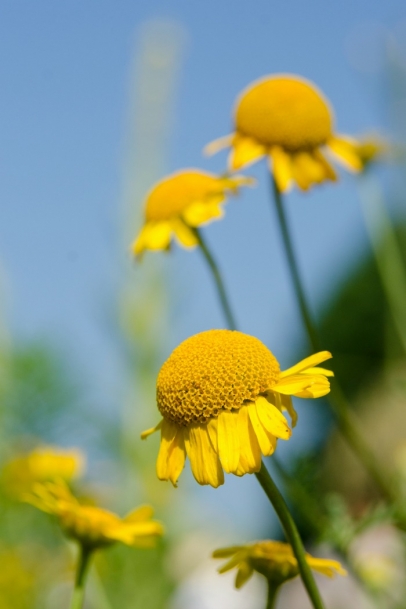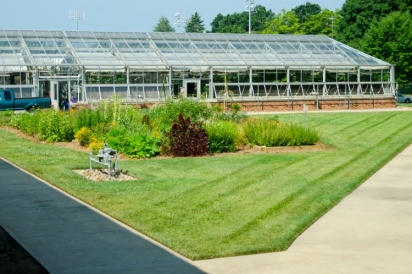Colors From the Earth: Inside the Furman University Ethnobotany Garden
Think back to your college biology class and you might conjure up the memory of fluorescent lights and the lingering smell of formaldehyde. But if you’re a student in one of Dr. Laura Thompson’s biology classes at Furman University, chances are your memories include some less conventional experiences— like the sun on your neck on a sultry May afternoon and the acrid steam of an indigo dye bath filled with t-shirts.
It’s a hot morning when I arrive on campus to meet Laura. I pass by stately old trees and carefully manicured lawns on my way to the Townes Science Center, home of the biology department. Everything inside and out is nice and neat and polished, as befits a thoroughly modern institute of higher learning.
But on the backside of the building it’s a different scene. Nestled between the science building and a gorgeous glass greenhouse lies the Furman Ethnobotany Garden, composed of three sections: the Fiber and Dye Plot, the Ethnomedicine Plot and the Bird Garden.
At the height of the growing season, the garden is a riot of blooms. I pick out the purple heads of Joe Pye weed, the rusty red sprays of “Hopi Red Dye” amaranth and the familiar orange frills of French marigold. Homemade bamboo tripods rise above even the towering mullein stalks, and Eastern bluebirds flit between these handy perches and the two bluebird boxes nearby. In the midst of it all, I catch sight of two figures; they turn out to be Laura and Katie Murray, a senior who’s working on a research project in the Bird Garden.
When Laura greets me she looks like a typical gardener—in her element in jeans and a t-shirt, wearing garden gloves and a wide-brimmed straw hat for protection from the sun cresting the top of the science building. But if you’d told her when she joined the Furman faculty 28 years ago that someday she would be teaching natural dyeing and maintaining an exten-sive garden as part of her job, she’d have called you crazy. “It’s nowhere near my actual professional training, but I love it,” she says.
That actual professional training is in molecular genetics. With a PhD from Virginia Tech, Laura still teaches traditional biology classes like Genetics and Plant Physiology. But she also teaches two classes that involve a substantial handson component and time in the Ethnobotany Garden: Live and Let Dye, a three-week May Experience intensive open to all Furman students, and Applied Plant Science, a semester-long class for biology and related majors. Live and Let Dye focuses solely on natural dyeing with natural fibers like wool, cotton, and silk, while Applied Plant Science also includes units on traditional foods, herbal medicine making, papermaking and more.
With a gardening father and a long personal history with the Girl Scouts, Laura’s love of nature has been a lifelong affair. But her adventures in dye gardening didn’t begin until she took a weeklong natural dyeing class at t he John C. Campbell Folk School in Brasstown, North Carolina. Buying in the dried plant material for her biology classes is expensive, so when she left the Folk School with some live madder roots she decided to try her hand at growing her own dyes. When Laura’s home garden turned out to be too shady for the plants, she had the idea to convert the sunny space behind the science building into a fiber and dye garden.
In 2011, Laura received an $800 faculty development grant from the Duke Endowment through the Shi Center for Sustainability and broke ground on the original 20 by 20 foot garden. She planted the madder roots in the new space as well as weld, alkanet, dyer’s coreopsis and lady’s bedstraw for a rainbow of natural colors. In 2012, Laura expanded the garden by half and added indigo and fiber plants like cotton and flax. The cotton is not only a vehicle for the dyes but also a valuable history lesson for Laura’s students, who find out just how tedious it is to gin raw cotton bolls by hand. “Do you guys appreciate your blue jeans now?” she asks of her Applied Plant Science class.
Madder root clearly has a special place in Laura’s heart; when I ask about her favorite dye plants, it tops the list. Depending on the type of mordant used for setting the dye, madder root yields sunny yellow-orange, vibrant brick red or rich red-brown. Some of her other favorites include Queen Anne’s lace, which results in olive and forest greens, and weld, which supplies intense yellows.
This year the garden measures 60 by 80 feet and Laura has a wish list of dye and fiber plants that she hopes to add: broomsedge, mimosa, osage orange and paper mulberry to name a few. She also has plans to expand her complement of medicinal herbs as part of the burgeoning Ethnomedicine Plot. Most people would look at it and think it’s just a patch of weeds, Laura says, but the Ethnobotanical Garden actually represents centuries of science and history. It serves as a point of connection for a new generation that is often far removed from the work of human hands.
Right before I go, Laura stops me and says, “You’re taking part of the garden with you.” I look down and see myriad sticky green and yellow seedpods clinging to my skirt. They’re from the nearby stand of agrimony, a natural dye plant and a traditional medicinal herb, and hitched a ride when I brushed by.
I return the seeds to the garden, but my mind dwells on what the students in Laura’s classes take away from this remarkable oasis of plant life: broadened horizons, new skills and a sense of accomplishment. In other words, exactly what you’re looking for during your college experience.
Dr. Laura Thompson
Professor of Biology
Furman University
3300 Poinsett Highway
Greenville
864-294-2085
laura.thompson@furman.edu







